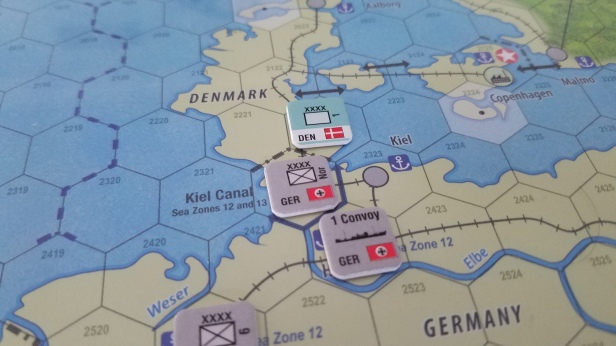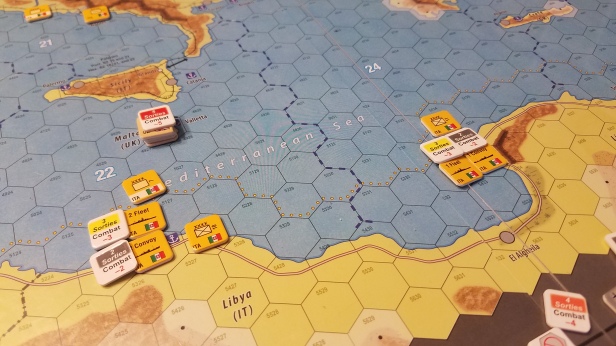August saw the collapse and conquering of France. The French colonies fell into disarray and Europe fell under the shadow of the Nazi banner. With the Spaniards joining the Axis, and Franco becoming bold enough to tackle the British Garrison in Gibraltar, the fate of Europe seems to have some very large question marks hanging over it.
Allies Defeated in Gibraltar and Denmark
The Axis declared war on the humble Danish during the declare war phase. Their one and only half strength ground army valiantly stared down the barrel at the Nazi war machine and bravely met their fate. It wasn’t really a fair fight, but these things so rarely are.

The Germans brought up the Luftwaffe in support and in preparation for the invasion of Norway via paratroop drop. The Germans rolled at a +4 with air support and the Danes at a -2 for being a reduced strength unit. Denmark was conquered within the space of just a couple of weeks.
Franco needed to mount almost all of his forces to give themselves the best chance of ousting the British from Gibraltar. In August, the British fought hard and the Spaniards were unable to round the rock and take control. September presented a different story. Finally, after centuries of disputation, the Spanish army marched into Gibraltar and the British surrendered.

With forces coming in from almost every side, the dice were cast. The modifiers were still almost equal, even with the overwhelming Spanish numbers. It’s another example of great design (in my opinion) that relays how difficult it is to capture a fortress, as well as the tenacity of the British forces defending their sovereignty. Unfortunately, the die rolls were not in the Allies favour, and even with the die roll being divided in two because of the fortress counter in Gibraltar, the Spanish were victorious.

The Spanish now are going to probably next turn their eye towards Portugal. The fighting will be fairly even handed, because of the lack of any natural modifiers built into each army, but the Spanish will relish controlling the Mid Atlantic and putting significant pressure on the British supply lines. I hadn’t thought about it that much until I was writing this AAR, but with Franco joining the war the conflict has taken on a significant new aspect. The age old bad blood between the Spanish and English from back in Elizabethan times and beyond has resurfaced. The armies are vastly different and the Spanish have no significant navy, but there’s just this great extra historical dynamic thrown in that I just love.

In Northern Europe the Luftwaffe ran some half-hearted sorties to try and deter the Royal Air Force but the defensive bonuses the RAF receive in the skies over Britain were too high to see them waste a significant amount of resources on.
Down in Northern Africa, the Italians and British have been trading blows in a stalemate around Tobruk. The WDF were however able to assault and conquer the fortress at Tobruk finally and the Italian garrison was forced to flee westwards toward Benghazi.

The British are hoping that the WDF will act as the hammer and that they can use the terrain, other units or even French North Africa (FNA), as the anvil on which to crush the Italians. The Italians had spent a lot of their resources ferrying down units to try and overwhelm the Brits which went about as well as could have been expected. Force H stationed in Malta was able to inflict a good number of sorties across the Italian Navy.
Force H acquired 5 sorties, which might seem like a high price to pay, but the Brits have very little power to do anything else in Europe so they often have a lot of production points wasted. They simply can’t spend them fast enough. So the Royal Navy has no problem doing something like this, whereas the Italians have a maximum of 12 production points, so between them attacking with ground units and removing sorties from their air force, they’ll have a much harder time recovering the sorties from their naval units.

I’m really enjoying the naval rules in the Med because they’re providing a unique challenge and also there’s a clear way for the British to be able to choke the life out of the Axis in the southern part of the game map. On first starting the campaign, I was concerned that the Royal Navy was under powered, because I didn’t fully grasp the way that the naval rules played out. Now, I’m really starting to get excited about the Air/Naval aspect of Unconditional Surrender! because it brings a refreshing change of pace to the ground combats that dominate the game. The rules aren’t all that complex and it’s just another thing to like.

Budapest became Pro-Axis during the Diplomatic Phase, which was the only thing that did happen. It’ll obviously be good for the Axis if more countries join, but it also would extend their south-eastern border closer to the Turkish USSR and the potential of opening up a larger front to fight in the East.
Thanks again for everyone who sticks around and reads these.
-Alexander



Alexander
I am really enjoying your AAR of UCE. It has been sitting on my shelf for a year as i remodel my house to get a space big enough to play it.
steve
LikeLiked by 1 person
Appreciate you reading! If I was going to remodel my house in order to play any game this would be it
LikeLike
I strongly recommend consulting one’s partner before remodeling a house in order to play USE. The object of the game is to have fun, not break relationships.
LikeLiked by 1 person
Not to worry – a price was paid !
LikeLiked by 1 person